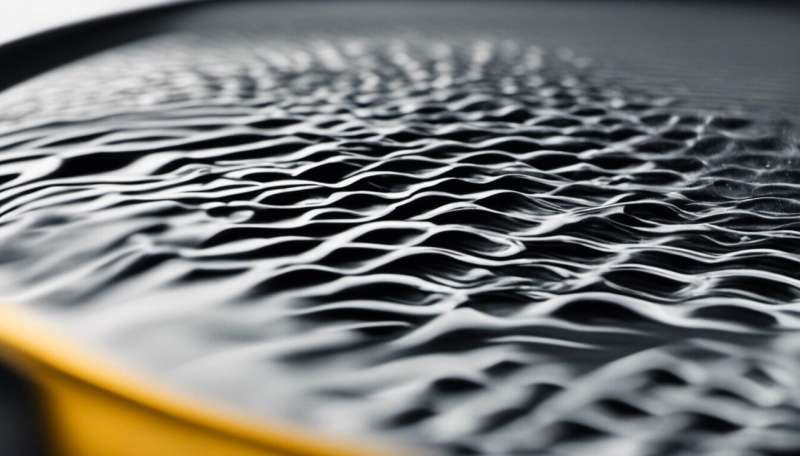This article has been reviewed according to Science X's editorial process and policies. Editors have highlighted the following attributes while ensuring the content's credibility:
fact-checked
trusted source
written by researcher(s)
proofread
Check your tires: You might be adding microplastics to the environment

Cost-saving measures are key in today's economic climate. But they can also have a positive impact on minimizing your environmental footprint. A prime example is maintaining your cars' optimal tire pressure.
Over time, tires naturally lose pressure—typically by around 1 psi a month. As pressure decreases, the tire becomes flatter, causing increased friction between the road and the tire itself. This heightened friction results in greater drag, reducing the lifespan of your tire and meaning more fuel is needed for travel.
But driving with flatter tires also increases the number of tire wear particles that are released into the environment. These particles—less than a millimeter in size—have been classified as microplastics due to their chemical makeup.
Tire wear stands out as a major source of microplastic pollution. Globally, each person is responsible for around 1kg of microplastic pollution from tire wear released into the environment on average each year—with even higher rates observed in developed nations.
It is estimated that between 8% and 40% of these particles find their way into surface waters such as the sea, rivers and lakes through runoff from road surfaces, wastewater discharge or even through airborne transport.
However, tire wear microplastics have been largely overlooked as a microplastic pollutant. Their dark color makes them difficult to detect, so these particles can't be identified using the traditional spectroscopy methods used to identify other more colorful plastic polymers.
To understand the extent of tire wear pollution, scientists have instead had to figure out ways to identify the chemicals that are associated with tires in water samples. Using these methods, tire wear chemicals have been found in 97% of river and estuary samples tested in Europe, the US and Japan.
And yet, we still know relatively little about the effects of tire wear pollutants on the health of marine animals. This is what my colleagues and I set out to discover in a recent study.
Filter feeders
Our study focused on two species common to estuaries in the north-east Atlantic—a bivalve called the peppery furrow shell and the ragworm. The bivalve feeds by filtering organic particles from the water and sediment.
The worm is primarily carnivorous, eating small creatures that live on the seafloor, but it also obtains some of its food from seawater and sediment. Both animals are likely to be exposed to tire wear particles and the potential toxins they contain.
We carried out two experiments. In the first, we exposed these animals to high concentrations of tire particles (10%) mixed into the sediment they burrow in for three days to see whether they ingested them. We then dissected the animals and counted any tire particles within their gastrointestinal tract.
Because the tire particles are rubbery, and could be compressed with a needle, we were able to analyze them under a microscope. We found that the worms only consumed small concentrations of tire particles (at most 33).
By contrast, the bivalves had large quantities of both sediment and tire particles in their stomachs—one bivalve had consumed over 1,000 tire particles.
In the second experiment, we exposed the animals to three concentrations of tire particles (0.2%, 1% and 5%) mixed into the sediment for three weeks. We did this to understand how this exposure affected their health.
We measured a number of health indicators, ranging from cellular to organism level. Bivalve health was affected at all of the concentrations tested, with feeding and burrowing impaired even at low concentrations (0.2%). At a high concentration (5%), we observed a decrease in protein content and an increase in oxidative stress.
Oxidative stress occurs when there are too many unstable molecules called free radicals in the body. These free radicals can lead to cell and tissue damage.
At low concentrations, the health of the worm was not affected. But we did observe a decrease in protein and energy content and signs of oxidative stress as exposure to tire wear particles increased.
Should we be concerned?
Concentrations of tire wear particles as high as 5% are unlikely in the natural environment. But our results are still worrying, particularly as the time in which the animals were exposed to the particles was short. The observed decrease in bivalve feeding and burrowing at low concentrations suggests exposure to tire wear microplastics in the wild will significantly impact this species.
Any decline in the health of these species could have a knock on effect on the wider marine ecosystem. Burrowing animals, like the bivalve, play crucial roles in recycling nutrients and enhancing photosynthesis. They are also an important food source for larger animals including birds, fish and crabs.
There is evidence that some of the chemicals that leach from these particles are toxic to marine animals. Research shows that they can reduce phytoplankton growth and harm the health of mussels.
The chemical make-up of tires varies depending on brand and car model—subsequently, toxicity will vary too. In the future, the complex mixture of components that go into the production of tires must be risk assessed more rigorously.
The chemicals that are found to have a negative impact on human and environmental health should then be substituted or removed, thereby reducing the impact of these microplastics in the environment.
Until then, there are several simple things you can do to help. These include maintaining the correct tire pressure, avoiding sharp braking or acceleration and reducing your vehicle load. All of these will reduce the amount of microplastics that your car releases into the environment.
Provided by The Conversation
This article is republished from The Conversation under a Creative Commons license. Read the original article.![]()





















